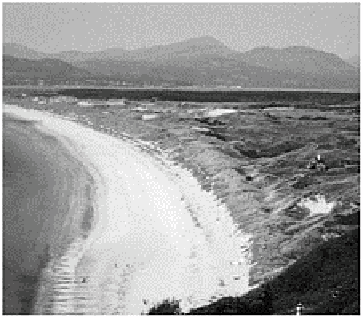Environmental Engineering Reference
In-Depth Information
Plate 1
The coastal dune system at Morfa Harlech, north Wales,
which now isolates Harlech Castle (1 km inland, out of view).
Seaward fore-dunes are separated from landward hind dunes by
dune slacks with a species-rich plant community. Blow-outs (bare
sand) are closely associated with tourist access routes to the beach.
Photo: Ken Addison.
KEY POINTS
1
Wind is dependent on the prior operation of other geomorphic processes which provide
fine-grained products. Wind deflates, i.e. entrains, removes and eventually deposits
these materials as metastable aeolian landforms. Armed with the abrasive tools, air
flow also scours bedrock surfaces in its path.
2
Aeolian landforms are found primarily in areas of atmospheric subsidence and
associated hot and cold arid zones, rather than in storm belts. Lack of protective
vegetation increases effective wind velocity in areas of lower absolute velocity and
exposes Earth materials to desiccation and deflation.
3
Tectonic processes exert secondary control through uplift, basin formation and the
creation of rain shadow. Upwelling cold ocean currents suppress rainfall and enhance
aridity on adjacent coasts.
4
Residual abraded rock surfaces, supporting lag gravels or scoured into yardangs, and
ergs or sand seas with dune and ripple bed forms at all scales, form the aeolian
landsystems of hot deserts. Loess sheets derived from glacial and frost desert
processes represent cold desert deflation products, especially beyond the margins of
Pleistocene ice sheets.
5
Aeolian processes are not restricted to arid climate zones. Physiological drought and the
availability of dry, fine-grained materials in coastal, mountain, urban and arable
farming environments all promote more localized aeolian activity Mid latitude land









